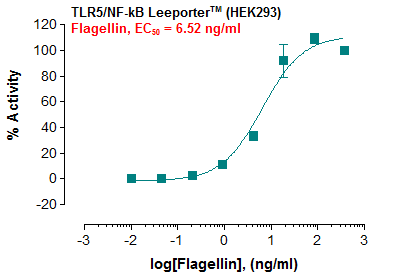Recombinant Human Receptor tyrosine kinase-like orphan receptor 1/ROR1 (C-6His)
Shipping Info:
For estimated delivery dates, please contact us at [email protected]
| Amount : | 50 µg |
| Content : | Lyophilized from a 0.2 µm filtered solution of PBS, pH7.4. |
| AA sequence : | Recombinant Human Inactive Tyrosine-protein Kinase Transmembrane Receptor ROR1 is produced by our Mammalian expression system and the target gene encoding Gln30-Glu403 is expressed with a 6His tag at the C-terminus. |
| Alternative Name : | Inactive tyrosine-protein kinase transmembrane receptor ROR1; Neurotrophic tyrosine kinase, receptor-related 1; ROR1; NTRKR1 |
Source : Human Cells;
Receptor tyrosine kinase-like orphan receptor 1 (ROR1), also known as neurotrophic tyrosine kinase, it is a member of the ROR family within receptor tyrosine kinases (RTK) superfamily. Human ROR1 is a type I transmembrane protein with 937 amino acids (aa) in length. It contains a 29 aa signal sequence, a 377 aa extracellular domain (ECD), a 21 aa transmembrane segment, and a 510 aa cytoplasmic region. ROR1 expressed strongly in human heart, lung and kidney, but weakly in the CNS. At developmental stage, it expressed at high levels during early embryonic development. ROR1 has been shown to have very low kinase activity in vitro and is unlikely to function as a tyrosine kinase in vivo. It may act as a receptor for wnt ligand WNT5A which may result in the inhibition of WNT3A-mediated signaling.
Receptor tyrosine kinase-like orphan receptor 1 (ROR1), also known as neurotrophic tyrosine kinase, it is a member of the ROR family within receptor tyrosine kinases (RTK) superfamily. Human ROR1 is a type I transmembrane protein with 937 amino acids (aa) in length. It contains a 29 aa signal sequence, a 377 aa extracellular domain (ECD), a 21 aa transmembrane segment, and a 510 aa cytoplasmic region. ROR1 expressed strongly in human heart, lung and kidney, but weakly in the CNS. At developmental stage, it expressed at high levels during early embryonic development. ROR1 has been shown to have very low kinase activity in vitro and is unlikely to function as a tyrosine kinase in vivo. It may act as a receptor for wnt ligand WNT5A which may result in the inhibition of WNT3A-mediated signaling.
|
There are currently no product reviews
|
















.png)









